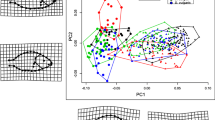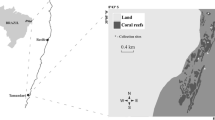Abstract
Recent work suggests that juvenile alewives (Alosa pseudoharengus) share similar phenotypes among independently derived landlocked (freshwater resident) populations. Based on this observation, it is possible that the alewife life history forms represent a case of parallel adaptive divergence. To further evaluate this hypothesis, we describe patterns of body shape divergence between anadromous and landlocked alewife life history forms using geometric morphometrics. Our results suggest that body shape differs significantly between juveniles of the alewife forms: anadromous fish were more robust, with larger heads and deeper caudal peduncles, while landlocked fish from three independently isolated populations were more fusiform with thinner caudal peduncles and smaller heads. These differences matched population level dietary patterns, which suggest that anadromous fish consumed more littoral resources than landlocked fish. Finding consistent differences across populations of the same form supports the notion that landlocked alewives have diverged from their anadromous ancestors in a parallel manner, in response to pressures associated with being isolated in freshwater lakes. Comparing alewife phenotypes to expectations from the literature suggests that neither migration distance of the population, nor the relative availability of habitats in each lake, are likely drivers of the pattern we report. Instead, the pattern is consistent with the hypothesis that divergence between alewife forms results from the distinct effects of each form on its zooplankton prey.



Similar content being viewed by others
References
Adams DC, Rohlf FJ, Slice DE (2004) Geometric morphometrics: ten years of progress following the ‘revolution’. Italian J Zool 71(1):5–16. doi:10.1080/11250000409356545
Aguirre WE (2009) Microgeographical diversification of threespine stickleback: body shape-habitat correlations in a small, ecologically diverse Alaskan drainage. Biol J Linn Soc 98(1):139–151. doi:10.1111/j.1095-8312.2009.01267.x
Bell MA, Andrews CA (1997) Evolutionary consequences of colonization of fresh water by primitively anadromous fishes. In: Streit B, Städler T, Lively CM (eds) Evolutionary ecology of freshwater animals: concepts and case studies. Birkhäuser, Basel, pp 323–363
Bookstein FL (1997) Morphometric tools for landmark data: geometry and biology. Cambridge University Press, Cambridge
Brooks JL, Dodson SI (1965) Predation body size and composition of plankton. Science 150:28–35. doi:10.1126/science.150.3692.28
Dadswell MJ, Klauda RJ, Moffitt CM, Saunders RL (1987) Common strategies of anadromous and catadromous fishes. American Fisheries Society, Bethesda
Domenici P, Kapoor BG (2010) Fish locomotion: an eco-ethological perspective. Science Publishers, Enfield
Domenici P, Turesson H, Brodersen J, Brönmark C (2008) Predator-induced morphology enhances escape locomotion in crucian carp. Proc R Soc Lond B 275:195–201
Drake AG, Klingenberg CP (2010) Large-scale diversification of skull shape in domestic dogs: disparity and modularity. Am Nat 175:289–301. doi:10.1086/650372
Fraser DJ, Bernatchez L (2005) Adaptive migratory divergence among sympatric brook charr populations. Evolution 59:611–624. doi:10.1554/04-346
Harrod C, Mallela J, Kahilainen KK (2010) Phenotype-environment correlations in a putative whitefish adaptive radiation. J Anim Ecol 79:1057–1068. doi:10.1111/J.1365-2656.2010.01702.X
Hendry AP, Wenburg JK, Bentzen P, Volk EC, Quinn TP (2000) Rapid evolution of reproductive isolation in the wild: evidence from introduced salmon. Science 290:516–518. doi:10.1126/science.290.5491.516
Jacobs RP, O’Donnell EB (2002) A fisheries guide to lakes and ponds of Connecticut, including the Connecticut River and its coves. Connecticut Department of Environmental Protection, Hartford
Jonsson B, Jonsson N (2001) Polymorphism and speciation in Arctic charr. J Fish Biol 58:605–638. doi:10.1006/Jfbi.2000.1515
Klingenberg CP (2011) MorphoJ: an integrated software package for geometric morphometrics. Mol Ecol Resour 11:353–357. doi:10.1111/j.1755-0998.2010.02924.x
Langerhans RB (2010) Ecology and evolution of swimming performance in fishes: predicting evolution with biomechanics. In: Domenici P, Kapoor BG (eds) Fish locomotion: an etho-ecological perspective. Science Publishers, Enfield, pp 200–208
Langerhans RB, Gifford ME, Joseph EO (2007) Ecological speciation in Gambusia fishes. Evolution 61:2056–2074. doi:10.1111/j.1558-5646.2007.00171.x
Lavin PA, McPhail JD (1986) Adaptive divergence of trophic phenotype among freshwater populations of the threespine stickleback (Gasterosteus aculeatus). Can J Fish Aquat Sci 43:2455–2463. doi:10.1139/f86-305
Lu GQ, Bernatchez L (1999) Correlated trophic specialization and genetic divergence in sympatric lake whitefish ecotypes (Coregonus clupeaformis): support for the ecological speciation hypothesis. Evolution 53:1491–1505. doi:10.2307/2640895
McPhail JD (1984) Ecology and evolution of sympatric sticklebacks (Gasterosteus)—morphological and genetic-evidence for a species pair in Enos Lake, British-Columbia. Can J Zool 62:1402–1408
McPhee MV, Noakes DL, Allendorf FW (2012) Developmental rate: a unifying mechanism for sympatric divergence in postglacial fishes? Curr Zool 58:21–34
Michel C, Hicks BJ, Stolting KN, Clarke AC, Stevens MI, Tana R, Meyer A, van den Heuvel MR (2008) Distinct migratory and non-migratory ecotypes of an endemic New Zealand eleotrid (Gobiomorphus cotidianus)—implications for incipient speciation in island freshwater fish species. BMC Evol Biol 8:49. doi:10.1186/1471-2148-8-49
Narum SR, Contor C, Talbot A, Powell MS (2004) Genetic divergence of sympatric resident and anadromous forms of Oncorhynchus mykiss in the Walla Walla River, USA. J Fish Biol 65:471–488. doi:10.1111/j.0022-1112.2004.00461.x
Palkovacs EP, Post DM (2008) Eco-evolutionary interactions between predators and prey: can predator-induced changes to prey communities feed back to shape predator foraging traits? Evol Ecol Res 10:699–720
Palkovacs EP, Post DM (2009) Experimental evidence that phenotypic divergence in predators drives community divergence in prey. Ecology 90:300–305. doi:10.1890/08-1673.1
Palkovacs EP, Dion KB, Post DM, Caccone A (2008) Independent evolutionary origins of landlocked alewife populations and rapid parallel evolution of phenotypic traits. Mol Ecol 17:582–597. doi:10.1111/j.1365-294X.2007.03593.x
Post DM (2002) Using stable isotopes to estimate trophic position: models, methods, and assumptions. Ecology 83:703–718. doi:10.1890/0012-9658(2002)083[0703:USITET]2.0.CO;2
Post DM, Palkovacs EP (2009) Eco-evolutionary feedbacks in community and ecosystem ecology: interactions between the ecological theatre and the evolutionary play. Philos T R Soc B 364:1629–1640. doi:10.1098/rstb.2009.0012
Post DM, Layman CA, Arrington DA, Takimoto G, Quattrochi J, Montana CG (2007) Getting to the fat of the matter: models, methods and assumptions for dealing with lipids in stable isotope analyses. Oecologia 152:179–189. doi:10.1007/s00442-006-0630-x
Post DM, Palkovacs EP, Schielke EG, Dodson SI (2008) Intraspecific variation in a predator affects community structure and cascading trophic interactions. Ecology 89:2019–2032. doi:10.1890/07-1216.1
Power ME, Tilman D, Estes JA, Menge BA, Bond WJ, Mills LS, Daily G, Castilla JC, Lubchenco J, Paine RT (1996) Challenges in the quest for keystones. Bioscience 46:609–620
Price SA, Holzman R, Near TJ, Wainwright PC (2011) Coral reefs promote the evolution of morphological diversity and ecological novelty in labrid fishes. Ecol Lett 14:462–469. doi:10.1111/j.1461-0248.2011.01607.x
Reznick D, Endler JA (1982) The impact of predation on life history evolution in Trinidadian guppies (Poecilia reticulata). Evolution 36(1):160–177
Riopel C, Robinson BW, Parsons KJ (2008) Analyzing nested variation in the body form of Lepomid sunfishes. Environ Biol Fish 82:409–420. doi:10.1007/s10641-007-9303-9
Robinson BW, Parsons KJ (2002) Changing times, spaces, and faces: tests and implications of adaptive morphological plasticity in the fishes of northern postglacial lakes. Can J Fish Aquat Sci 59(11):1819–1833. doi:10.1139/F02-144
Robinson BW, Wilson DS (1994) Character release and displacement in fishes—a neglected literature. Am Nat 144:596–627. doi:10.1086/285696
Rohlf J (2010) TPSDig2. 2.16, Department of Ecology and Evolutionary Biology, SUNY, Stony Brook
Rohlf FJ, Slice D (1990) Extensions of the Procrustes method for the optimal superimposition of landmarks. Syst Zool 39(1):40–59. doi:10.2307/2992207
Schielke EG, Palkovacs EP, Post DM (2011) Eco-evolutionary feedbacks drive niche differences in alewives. Biol Theory 6:211–219. doi:10.1007/s13752-012-0031-9
Schluter D (1996) Ecological speciation in postglacial fishes. Philos T R Soc B 351:807–814. doi:10.1098/rstb.1996.0075
Schluter D (2000) The ecology of adaptive radiation. Oxford series in ecology and evolution. Oxford University Press, Oxford
Schoener TW (2011) The newest synthesis: understanding the interplay of evolutionary and ecological dynamics. Science 331:426–429. doi:10.1126/science.1193954
Sidlauskas BL, Mol JH, Vari RP (2011) Dealing with allometry in linear and geometric morphometrics: a taxonomic case study in the Leporinus cylindriformis group (Characiformes: Anostomidae) with description of a new species from Suriname. Zool J Linn Soc Lond 162:103–130. doi:10.1111/J.1096-3642.2010.00677.X
Sih A, Crowley P, McPeek M, Petranka J, Strohmeier K (1985) Predation, competition, and prey communities: a review of field experiments. Annu Rev Ecol Syst 16:269–311
Silva A (2003) Morphometric variation among sardine (Sardina pilchardus) populations from the northeastern Atlantic and the western Mediterranean. ICES J Mar Sci 60:1352–1360. doi:10.1016/S1054-3139(03)00141-3
Smith TB, Skúlasson S (1996) Evolutionary significance of resource polymorphisms in fishes, amphibians, and birds. Annu Rev Ecol Syst 27:111–133. doi:10.1146/Annurev.Ecolsys.27.1.111
Stone HH, Daborn GR (1987) Diet of alewives, Alosa pseudoharengus and blueback herring, A. aestivalis (Pisces: Clupeidae) in Minas Basin, Nova Scotia, a turbid, macrotidal estuary. Environ Biol Fish 19:55–67. doi:10.1007/BF00002737
Stone HH, Jessop BM (1994) Feeding habits of anadromous alewives, Alosa pseudoharengus, off the Atlantic coast of Nova Scotia. Fish B NOAA 92:157–170
Svanback R, Eklov P (2004) Morphology in perch affects habitat specific feeding efficiency. Funct Ecol 18:503–510. doi:10.1111/j.0269-8463.2004.00858.x
Taylor EB, Foote CJ (1991) Critical swimming velocities of juvenile sockeye salmon and kokanee, the anadromous and non-anadromous forms of Oncorhynchus nerka (Walbaum). J Fish Biol 38:407–419. doi:10.1111/j.1095-8649.1991.tb03130.x
Varian A, Nichols KM (2010) Heritability of morphology in brook trout with variable life histories. PLoS ONE 5(9):e12950. doi:10.1371/journal.pone.0012950
Walker JA (1997) Ecological morphology of lacustrine threespine stickleback Gasterosteus aculeatus L. (Gasterosteidae) body shape. Biol J Linn Soc 61:3–50. doi:10.1111/j.1095-8312.1997.tb01777.x
Walker JA, Bell MA (2000) Net evolutionary trajectories of body shape evolution within a microgeographic radiation of threespine sticklebacks (Gasterosteus aculeatus). J Zool 252:293–302
Ward AJW, Webster MM, Hart PJB (2006) Intraspecific food competition in fishes. Fish Fish 7:231–261. doi:10.1111/j.1467-2979.2006.00224.x
Weihs D (1989) Design features and mechanics of axial locomotion in fish. Am Zool 29:151–160
Wilson DS (1998) Adaptive individual differences within single populations. Philos T R Soc B 353:199–205. doi:10.1098/rstb.1998.0202
Wood CC, Foote CJ (1996) Evidence for sympatric genetic divergence of anadromous and nonanadromous morphs of sockeye salmon (Oncorhynchus nerka). Evolution 50:1265–1279. doi:10.2307/2410667
Zelditch M (2004) Geometric morphometrics for biologists: a primer. Elsevier Academic Press, Amsterdam
Acknowledgments
We thank R. Beinart, J. Brodersen, T. Hanley, J. Howeth, M. Sorenson, J. Vellota, M. Walsh, J. Weis, and D. West for their assistance in the field and lab, and G. Olack and D. Collosi for their assistance with stable isotope analysis. Comments by anonymous reviewers, T. Hanley and M. Walsh helped significantly improve this manuscript. This research was supported by NSF DEB No. 0717265 to D. M. Post, and an NSF GRF to A. W. Jones.
Author information
Authors and Affiliations
Corresponding author
Rights and permissions
About this article
Cite this article
Jones, A.W., Palkovacs, E.P. & Post, D.M. Recent parallel divergence in body shape and diet source of alewife life history forms. Evol Ecol 27, 1175–1187 (2013). https://doi.org/10.1007/s10682-013-9650-2
Received:
Accepted:
Published:
Issue Date:
DOI: https://doi.org/10.1007/s10682-013-9650-2




